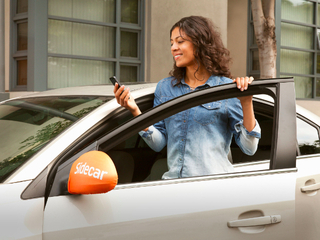
GM buys Cruise to go deeper into self-driving cars
General Motors also recently partnered with Lyft and bought the remains of Sidecar

For a while it seemed like the fight for the self-driving car was going to come down to three companies: Apple, Google and Uber. Now there's a new player on the scene, one that has been making big moves in the space over the last few months.
That would be General Motors, which announced the acquisition of Cruise Automation, a developer of self-driving technology, on Friday. No financial terms of the deal were disclosed, though it is being pegged at over $1 billion by some reports.
The San Francisco-based Cruise was the developer of technology “kits” that were able to turn cars, specifically the Audi S4 or A4, into an self-driving vehicle.
GM says it will be using Cruise's talent and rapid development capability to accelerate its "development of autonomous vehicle technology." GM engineers working on autonomous vehicle projects will continue their work, such as on Super Cruise hands-free driving technology that will debut in 2017 on the Cadillac CT6.
Cruise will operate as an independent unit within GM’s recently formed Autonomous Vehicle Development Team, which is led by Doug Parks, vice president of autonomous technology and vehicle execution at GM. Cruise will also continue to be based in San Francisco.
For the company, becoming a part of GM will give it access to more resources to broaden its technology, and to bring it to a larger number vehicles.
“GM's commitment to autonomous vehicles is inspiring, deliberate, and completely in line with our vision to make transportation safer and more accessible,” Kyle Vogt, founder of Cruise Automation, said in a statement. “We are excited to be partnering with GM and believe this is a ground-breaking and necessary step toward rapidly commercializing autonomous vehicle technology.”
Founded in 2013, Cruise had raised $18.8 million in venture funding from investors that included AME Cloud Ventures, CrunchFund, Felicis Ventures, Homebrew, and Initialized Capital, among others.
This is GM's second big purchase in the driverless car space in just the last few months. In January it acquired the remaining assets of ridesharing company Sidecar.
Sidecar had been one of the first to offer ridesharing, but it was unable to compete against Uber and Lyft. Eventually it began focusing on an on-demand delivery service for third-party merchants. That didn't workand it was forced to shut down in December.
GM bought the team and technology to accelerate their mobility plans and grow their new mobilityoffering. The key component to the transaction was a license to Sidecar's patents, which Sidecar retainsownership of.
In addition to that, GM also invested in Lyft, contributing $500 million to its $1 billion round, while also announcing that the two companies are working togteher on a new “Autonomous On-Demand Network,” combining the car company’s developments in autonomous vehicles with Lyft’s software for ridematching, routes, and payments.
The deal also included a series of national rental hubs where Lyft drivers can rent vehicles on a short-term basis, i.e. while they’re driving around for Lyft. The idea is likely to expand the pool of people thatcan drive for Lyft from those who own Priuses to anyone who can get a ride to a Lyft/GM rental hub.
GM also launched a car-sharing service called Maven, with the mission of giving customers access to on-demand mobility services. That means they can use an app to search for and reserve a vehicle bylocation or car type and unlock the vehicle with their smartphone.
The global Maven team includes more than 40 employees from the connected car technology industry as well as ride- and car-sharing professionals from Google, Zipcar and Sidecar.
So obviously General Motors sees the opportunity in the self-driving car space, and is ramping up its efforts pretty quickly. It will have a few established players to deal with, though, who have been working inthis space for a while.
Google began testing driverless cars all the way back in 2011 in Nevada, with the vision of self-driving cars roaming our city streets, ready to be accessed on-demand, just yellow cabs are. When Google starts to offering rides to people, that will put it into direct competition with e-hailing apps, like Uber and Lyft.
In September, Google hired TrueCar president John Krafcik as CEO of its self-driving car project, as part of the company's restructuring as Alphabet.
Even if Google is ready to compete with it, Uber is not about to be left behind. It announced last year that it is working on its own self-driving vehicles at the Advanced Technologies Center located Pittsburgh, Pa, near the Carnegie Mellon University (CMU) campus. The facility is the offspring of a strategic partnership between Uber and CMU.
It is Apple, though, that might get there first, before either Google or Uber. The company has stated that it plans to have its first car done by 2019. Though it would not be a driverless car, it would obviously be a big step toward bringing such a vehicle onto the road.
(Image source: getcruise.com)
Related News


Consumers are ready for driverless cars

Food delivery pivot fails to save Sidecar

Volvo will take blame if a self-driving car is in a crash

Google wants its driverless cars to talk to pedestrians

Google and Uber will compete over the driverless car

Regulator says Google's self-driving cars count as drivers

Report: Google will turn driverless cars into own company

